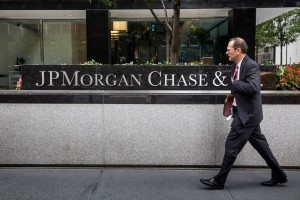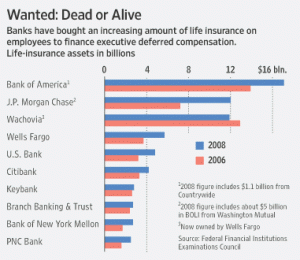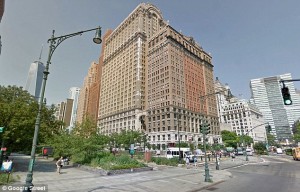by James Corbett
TheInternationalForecaster.com
June 3, 2015
29-year-old investment banker Thomas Hughes died in the early morning hours last Thursday after apparently falling from the 24th floor of his Manhattan apartment building. The Daily Mail‘s coverage of the incident is revealing, not because it sheds light on what actually happened to Hughes, but because it deftly buries the most interesting aspects of the case under a sea of speculation and hand-waving.
“Exclusive: Father of investment banker, 29, fears son turned to drink and drugs to cope with stress and jumped to his death after a ‘Wolf of Wall Street cocaine party’!” blares the typically unwieldy tabloid title, and sadly the reporting does not rise above the level of that headline. After noting that Hughes is in fact the 12th person in high finance so far this year to take their own life (if that is indeed what they did), the newspaper informs us that this has prompted a “renewed focus on the demands that Wall St places on young bankers.”
And his father’s “fear” that Thomas “jumped to his death after a ‘Wolf of Wall Street Cocaine party’?” If you can cover up the sidebar on the right-hand side of the DM’s clickbait-infested site long enough to actually read the article, you’ll find out that this is not what his father was actually saying. “I wish I would have crystal clear answers. If you met him you would say this is the opposite person who would seem like the kind of person who was considering taking this type of action,” the father was quoted as saying after asserting that his son was “enjoying his work.”
So what is happening here? Why are MSM outlets like the Daily Mail rushing to wrap this up as “just another suicide of an over-stressed banker” before the police have even identified the body (which was unrecognizable after impact)?
 The answer might just lie in Hughes’ resume. Although he worked for Park Avenue investment bank Moelis & Company at the time of his death, his Financial Industry Regulatory Authority (FINRA) profile indicates he interned at JPMorgan Chase before going on to stints at UBS and Citibank.
The answer might just lie in Hughes’ resume. Although he worked for Park Avenue investment bank Moelis & Company at the time of his death, his Financial Industry Regulatory Authority (FINRA) profile indicates he interned at JPMorgan Chase before going on to stints at UBS and Citibank.
Although you could be forgiven for having blinked-and-missed-it in the midst of the wall-to-wall coverage of the earth-shatteringly important Caitlyn Jenner kerfuffle, those three banks were part of the sextet that were just found guilty of manipulating the $5 trillion-a-day foreign exchange market and were collectively fined an impressive-sounding but ultimately trivial (to them) $6 billion for the crime.
While this connection in and of itself may not be the answer to the Hughes riddle, it takes on a new light when we look at some positively ghoulish information on “dead peasants insurance” in the banking industry. For those who don’t know, “dead peasants insurance” is known in the business world as “COLI” or “corporate-owned life insurance” and on Wall Street as “BOLI,” i.e., “bank-owned life insurance.” These are life insurance policies that are taken out by corporations for their employees. In the event of the death of that employee, the corporation gets the payout, often behind the back of the employee’s family.
Although COLI/BOLI is traditionally painted in the media as little more than a tax deduction scheme, Ellen E. Schultz uncovered an altogether more sinister possibility. In her 2011 book Retirement Heist: How Companies Plunder and Profit from the Nest Eggs of American Workers, Schultz published a memo from an insurance agent to Mutual Benefit Life Insurance Co. discussing these types of insurance policies. The agent notes how firms like Procter & Gamble and Diebold were ‘suffering’ from low employee death rates (and thus low life insurance payoffs), but one firm had a significantly higher rate:
“A company the agent called NCC had a better death rate, he noted. People were dying at 78 percent expected mortality. ‘However, this includes three suicides within the first year which is highly unusual’— NCC had not had one suicide in twenty-five years until 1990. ‘Without these suicides, NCC would be running at 33% expected mortality. This fact highly concerns me.’”
 As Wall Street on Parade pointed out in an explosive report on the subject one year ago, Wall Street, too, is heavily invested in these types of insurance policies. That report detailed how Wall Street’s four largest banks hold as much as $681 billion in life insurance in force on their employees, past and present, and JPMorgan holds up to $179 billion of that total.
As Wall Street on Parade pointed out in an explosive report on the subject one year ago, Wall Street, too, is heavily invested in these types of insurance policies. That report detailed how Wall Street’s four largest banks hold as much as $681 billion in life insurance in force on their employees, past and present, and JPMorgan holds up to $179 billion of that total.
And now, coincidentally, JPMorgan has been experiencing an unusual number of “suicides” and unusual deaths of young workers since the so-called “bankster suicide” phenomenon began in December of 2013.
This list includes the likes of Andrew Jarzyk, another former tech intern at JPMorgan who went missing and was found dead in the Hudson River in 2014 in circumstances that have still never been explained.
Or Gabriel Magee, the Vice-President of IT at JPMorgan who apparently threw himself from the 32nd floor of the bank’s London headquarters after sending his girlfriend a text that he would be home late that evening.
Or Kenneth Bellando, a former JPMorgan analyst whose JPMorgan-employed brother was mentioned in a Senate investigation into Morgan’s $6.2 billion Whale derivatives disaster that slammed the bank for lying to regulators.
Although there has been a larger pattern of bankster deaths identified by others in the past year and a half, it’s the JPMorgan pattern that sticks out: Young interns and analysts, many of them tech workers for the banking giant, are ending up dead in unusual circumstances.
Could this be, as the Daily Mail and its ilk are all too keen to suggest, simply a case of overworked young investment bankers choosing the easy way out? It’s a possibility. But could it be something much more sinister? A heartless scheme to help meet the company’s dead peasant mortality projections? Or an attempt to silence potential whistleblowers about the systems JPMorgan is using to game the markets? These, too, are possibilities, though ones that will never be broached by the lapdog media.









Great article, thank you James. It’s anecdotal in a sense but it has been shown that high finance and banking attracts a high proportion of people who register as psychopathic – see the book Snakes in Suits, When Psychopaths Go To Work by Robert Hare – and by inference I would not deem it outlandish to suggest that working in that world is a dangerous, even life threatening, enterprise.
They are not getting brownie points from the duped masses, but the UN. Gotta complete them SDG’s…(see page #12, goal #5)
https://sustainabledevelopment.un.org/content/documents/7261Post-2015%20Summit%20-%202%20June%202015.pdf
This is a nice investigative effort to make visible the patterns in which these suicides occur.
Having said that, there is another indication to solidify the suspicions derived from these emerging patterns that is kind of important:
Do these insurance policies in question stipulate denial of payments in case of suicide?
To the best of my knowledge suicide is ruled out as a cause of death for claims in all life-insurances, as it obviously sets very questionable incentives.
I am no expert, and I hope to see more knowledgeable comments here.
You raise a very important point, Muessin. I know there was a FOIA request to the Office of the Comptroller of the Currency to disclose details about the nature of these BOLI policies. The OCC’s response? No info can be given because it’s a trade secret:
Insurance policies pertaining to bankers’ suicides classified as containing ‘trade secrets’
If anyone has any more specific info on these policies I’d love to see it.
Ok, thanks James – the Wall Street on Parade blog article mentioned in that RT report is also very interesting and ties in with the WSOP piece mentioned above in James’ article , with some more details on the data and the sources they tapped.
A memorble quote:
“The Wall Street banks are using a process called “separate accounts” for large amounts of their BOLI assets with reports of some funds never actually leaving the bank and/or being invested in hedge funds, suggesting lessons from the past have not been learned.”
The article goes on quoting a Bloomberg report that explains how Wachovia et al. got fleeced by Citigroup run hedge funds speculating on their insurance accounts to the tune of $315 million dollars. A practice that is also alluded to in the WSOP piece mentioned above in James’ article.
Throwing all these millions and billions for third-party life-insurances around… dumping them in “competitor’s” hedge funds… you couldn’t come up with that in a script…
Oh, that was before the site upgrade last year. Now I’m on a current theme that seems to be working more or less fine on my end. But please do report any bugs or problems if you see them.
TOP JPMorgan BANKER JIMMY LEE DIES “UNEXPECTEDLY” AT AGE 63.
http://nypost.com/2015/06/17/jimmy-lee-top-jpmorgan-banker-dead-at-62/
Not a suicide but, seems rather mysterious. He was exercising one morning, felt a shortness of breath, went to the hospital, then died. Jamie Dimon said he died “unexpectedly.”
As the dean of the banking industry, Lee scored many of JPMorgan’s biggest deals, including Comcast’s $30 billion purchase of NBCUniversal and General Motors’ $23 billion initial public offering.
More recently, he helped the bank secure a lead position on Alibaba’s record-setting $25 billion IPO last year.
While Lee was considered larger than life, he was also a team player. He came to Dimon’s defense when he was under fire for the disastrous $6 billion London Whale trade, saying Dimon “has moral courage running through his veins.”
Also…
Lee built his career at Chemical Bank, where he became a key figure in the syndicated loans and eventually leveraged buyouts. Some call him the inventor of the syndicated loan market.